 Nuclear forces differ
Nuclear forces differsuch that nuclear fission is not nuclear fusion!
Fission occurs when a neutron destabilizes very heavy elements engendering the nuclei to split into two lighter elements. Fission means to break-up or split in two.
Fission | weak nuclear force | question | Fusion | strong nuclear force | description of fusion | less massive elements | curve of binding (strong) energy | summary
Fusion, meaning to fuse or combine different objects.
| This is a depiction of nuclear fusion | ||
|---|---|---|
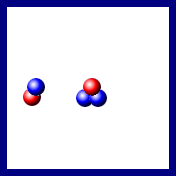 |
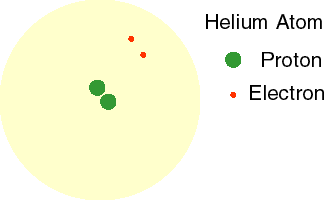 |
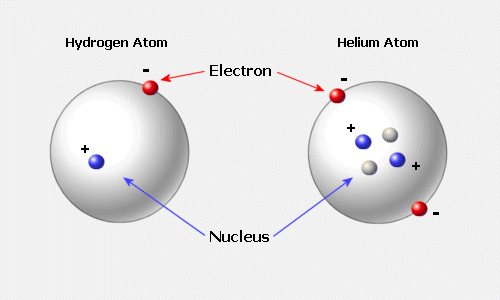 |
Fusion is the expression of the strong nuclear force that binds atomic nuclei into 92 natural occurring atomic elements. The strong nuclear force is one of four fundamental forces that account for the energy transformations that fuel the universe. The strong nuclear force is what holds or binds the the material world together on the molecular and atomic scales.
Fission | weak nuclear force | question | Fusion | strong nuclear force | description of fusion | less massive elements | curve of binding (strong) energy | summary
 Question: what is fission ( bombs and reactors are fueled by this process ) and how is it graphically depicted?
Question: what is fission ( bombs and reactors are fueled by this process ) and how is it graphically depicted?
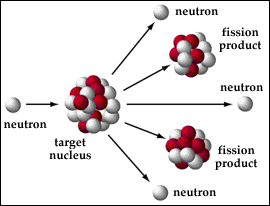
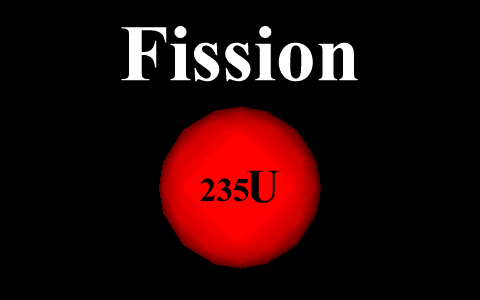
.gif)

More massive elements that are unstable and capable of radioactive decay under the influence of the weak nuclear force are called "fissionable material." Fission means to break up, or come apart.
This fissioning results in quite a small amount of mass being converted into enormous reservoirs of energy that instantaneously explode with a force proportionate to the mass subject to radioactive decay. The extent of the released atomic energy is governed by the formula E=MC2.
Fission | weak nuclear force | question | Fusion | strong nuclear force | description of fusion | less massive elements | curve of binding (strong) energy | summary
Less massive elements may fuse, as in the core of stars, supernova, or reactors.
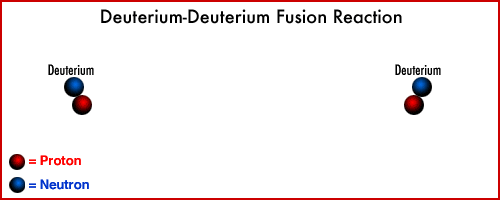
Fusion is more powerful than fission and is the force that keeps stars fueled with hydrogen H as it fuses into He; helium. Hydrogen is the most abundant element in our universe.
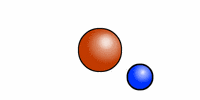 H - a typical hydrogen atom is one proton & a single electron.
H - a typical hydrogen atom is one proton & a single electron.
Fission | weak nuclear force | question | Fusion | strong nuclear force | description of fusion | less massive elements | curve of binding (strong) energy | summary

The atom is actually invisibly small and paradoxically mostly comprised of emptiness; with the mass concentrated in the atomic nuclei of elements.
Fission | weak nuclear force | question | Fusion | strong nuclear force | description of fusion | less massive elements | curve of binding (strong) energy | summary
Depicted below, the curve of binding energy is a basic conceptual framework that accounts for the mass and equivalent electrical charges that distinguish the universal forces working on less massive as opposed to more massive atomic elements.
| million of electron volts | 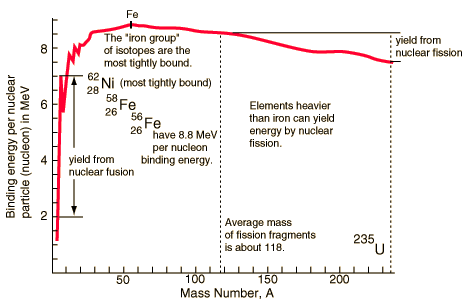
|
|
 |
 |
|
 |
||
| capable of fusion | fissionable | |
![]()
Fission | weak nuclear force | question | Fusion | strong nuclear force | description of fusion | less massive elements | curve of binding (strong) energy | summary
Nuclear power is actually the use of volatile uranium or plutonium (or other radioactive) fuel to heat water to the boiling point. At the boiling point, water flashes into steam with sufficient force to drive electric generating turbines. These turbines turn electromagnets to generate electricity. By volatile uranium or plutonium fuel we mean fissile material fissionable elements that release energy when controlled in a situation when these elements are bombarded by slow neutrons. The control rods in any diagram of a nuclear power plant are capable of absorbing excess, stray fission fragments; by doing so this modulates the fission reaction.
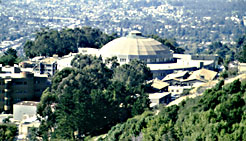
Lawrence Berkeley nuclear laboratory
Fission | weak nuclear force | question | Fusion | strong nuclear force | description of fusion | less massive elements | curve of binding (strong) energy | summary
Science | Technology | Fundamentals | Relationship